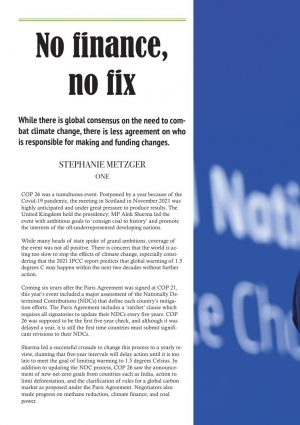 COP 26 was a tumultuous event. Postponed by a year because of the Covid-19 pandemic, the meeting in Scotland in November 2021 was highly anticipated and under great pressure to produce results. The United Kingdom held the presidency; MP Alok Sharma led the event with ambitious goals to ‘consign coal to history’ and promote the interests of the oft-underrepresented developing nations.
COP 26 was a tumultuous event. Postponed by a year because of the Covid-19 pandemic, the meeting in Scotland in November 2021 was highly anticipated and under great pressure to produce results. The United Kingdom held the presidency; MP Alok Sharma led the event with ambitious goals to ‘consign coal to history’ and promote the interests of the oft-underrepresented developing nations.
While many heads of state spoke of grand ambitions, coverage of the event was not all positive. There is concern that the world is acting too slow to stop the effects of climate change, especially considering that the 2021 IPCC report predicts that global warming of 1.5 degrees C may happen within the next two decades without further action.
Coming six years after the Paris Agreement was signed at COP 21, this year’s event included a major assessment of the Nationally Determined Contributions (NDCs) that define each country’s mitigation efforts. The Paris Agreement includes a ‘ratchet’ clause which requires all signatories to update their NDCs every five years. COP 26 was supposed to be the first five-year check, and although it was delayed a year, it is still the first time countries must submit significant revisions to their NDCs.
Sharma led a successful crusade to change this process to a yearly review, claiming that five-year intervals will delay action until it is too late to meet the goal of limiting warming to 1.5 degrees Celsius. In addition to updating the NDC process, COP 26 saw the announcement of new net-zero goals from countries such as India, action to limit deforestation, and the clarification of rules for a global carbon market as proposed under the Paris Agreement. Negotiators also made progress on methane reduction, climate finance, and coal power.
Methane Reduction
The Global Methane Pledge was a significant achievement for this year’s meeting. Originally introduced by the EU and US, over 100 countries signed onto the pledge to cut methane emissions by 30% by 2030. Methane has an outsized effect on short term climate change – in the first 20 years after emission, it is 80 times more powerful than CO2 at trapping atmospheric heat. Therefore, cutting methane emissions in the short term could significantly limit warming to 1.5 degrees C.
While the announcement of this initiative is an important step in the right direction, it is also critical to examine implementation details. One encouraging aspect of the statement is that it already has financial and technical support attached. In addition to $328 million in philanthropic support, international finance institutions such as the European Investment bank have signed on to provide project finance. However, the commitment is voluntary, and major emitters such as China, Russia, and India are not signatories.
United States President Joe Biden has also proposed stricter domestic methane rules in tandem with the COP announcement. The new rule focuses on reducing methane emissions from the oil and gas industry. Biden, attempting to regain the United States’ international leadership role, announced the new law on November 2nd to coordinate it with the rollout of the Global Methane Pledge. However, the US has declined to participate in the International Methane Emissions Observatory, a programme by the UN to monitor global methane emissions. This contradiction in US policy illustrates the difficulty in translating pledges into action.
Climate Finance
A critical aspect of this year’s COP was negotiations over climate finance. In particular, it was time to reexamine the pledge, made in 2009, that developed countries would mobilize $100 billion per year in climate finance for developing nations. While there is global consensus on the need to combat climate change, there is less agreement on who is responsible for making and funding changes. Like any collective action problem, climate change mitigation strategies require full participation to be effective. Still, there is a strong incentive for individual actors (or nations) to free ride on others’ efforts. Developing countries also make claims of injustice because of the historic advantages conferred onto developed nations from the unlimited use of fossil fuels. The $100 billion climate finance pledge was a key part of addressing these disparities. Unfortunately, this goal has not yet been reached, and of the money currently provided, 70% has been in the form of loans.
The parties at COP26 have reaffirmed their commitment to the $100 billion finance goal, and they expect to reach it by 2023. However, developing countries have expressed reservations about the role of private finance in meeting this promise. Using loans for climate projects ultimately still puts the burden of funding mitigation efforts on developing countries. Many developing countries already have high sovereign debt burdens, and the covid-19 crisis exacerbated this issue: low-income countries’ debt increased to $860 billion in 2020, a 12% increase from 2019. Accordingly, developing countries are reluctant to take on more debt than necessary, especially to address a problem that they perceive to be the fault of the high-income countries. While grant funding might be a preferable method, developed countries are not always keen to fund projects with no expected return. Internal political pressure in countries such as the United States makes it difficult to ratify purely charitable funding agreements.
The issue of climate finance will continue to be of critical importance as the need for mitigation and adaptation projects expands over time. Financial commitments from developing countries are vital for promoting decarbonization in countries that may otherwise be reluctant to participate in climate agreements for fear of slowing their development. The COP26 published a Climate Finance Delivery Plan, which laid out the priorities for future efforts. Developed countries agreed to mobilize more finance, including more grants for the lowest income countries.
There is also an increasing focus on adaptation, as many countries already feel the effects of climate change. The next few years will be extremely important for developing trust between developed and developing countries – developed nations need to follow through on their commitments or risk losing credibility.
“Phase down” of coal power
COP President Sharma made eliminating coal power a major goal for the UK COP Presidency. Negotiators included the “phase-out” of coal power as a critical aspect in the COP 26 agreement, though the text did not include specifics such as a timeline. However, at the final hour, China and India signalled that they would not sign the agreement with the current language. As the world’s biggest coal users, they protested that coal was still essential to their growth and committing to a phase-out was impossible at this time. Instead, negotiators settled on a new phrase – countries would work to “phase down” unabated coal. This wording leaves room for some coal in the future energy system, and it still permits abated coal power, meaning the use of carbon capture and storage (CCS).
While China and India were blamed for the new language, other countries also cheered the change. For example, Australia still considers coal as key to its economy, and its updated NDC will not increase the ambition of the country’s 2030 emissions reductions targets. Other major producers of fossil fuels, such as Saudi Arabia and South Africa, also quietly expressed displeasure with the original wording. While President Sharma and other European representatives left the conference feeling disappointed in the outcome, it is important to note that this is the first time fossil fuels have been explicitly addressed in a COP agreement. Moreover, acknowledging the need to reduce coal use from China and India represents a significant shift from their stance at previous COPs.
As with the other aspects of the agreement, it will be impossible to measure the impact of the “phase down” clause immediately. Some countries already have plans to phase out coal completely; for example, many EU nations have deadlines to close any remaining coal plants within the next 5 to 15 years.
Many developing countries have also recently deprioritized the role of coal within their electricity systems. For instance, Vietnam’s Power Development Plan 8 has reduced the planned coal power capacity through 2030, in line with its recent net-zero pledge. This case is likely to be representative of the path for many developing countries – a conscious effort to reduce their reliance on coal but no plans for an immediate exit.
COP commitments vs reality
It is always difficult to measure the success of international meetings such as COP until countries have the time to implement their commitments. This fact often leads to criticism of such meetings as being all talk, no action, or merely a chance for high-level leaders to show off with grand speeches without having to make real change.
While this criticism is valid, it also undervalues the diplomatic process. International agreements are an important first step to establishing baseline expectations and accountability measures for a specific issue. For example, this year’s agreement on methane emissions is a new achievement for the COP, which has never produced a comprehensive deal on methane.
Still, scientists have increasingly realized that this decade will be vital in determining the ultimate level of planetary warming. Actions taken through 2030 will either enable sufficient decarbonization or show that the world is still falling behind in its efforts. Accordingly, it is imperative to monitor how countries implement the new agreements from COP26.
The new yearly review of NDCs should help to increase oversight. Delivering on finance commitments will also be key. Ultimately, each country has its plan to combat climate change, and COP is more of an overarching framework than a specific guide.
Stephanie Metzger





